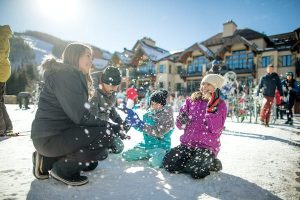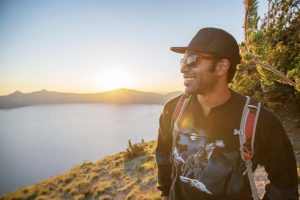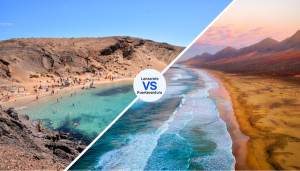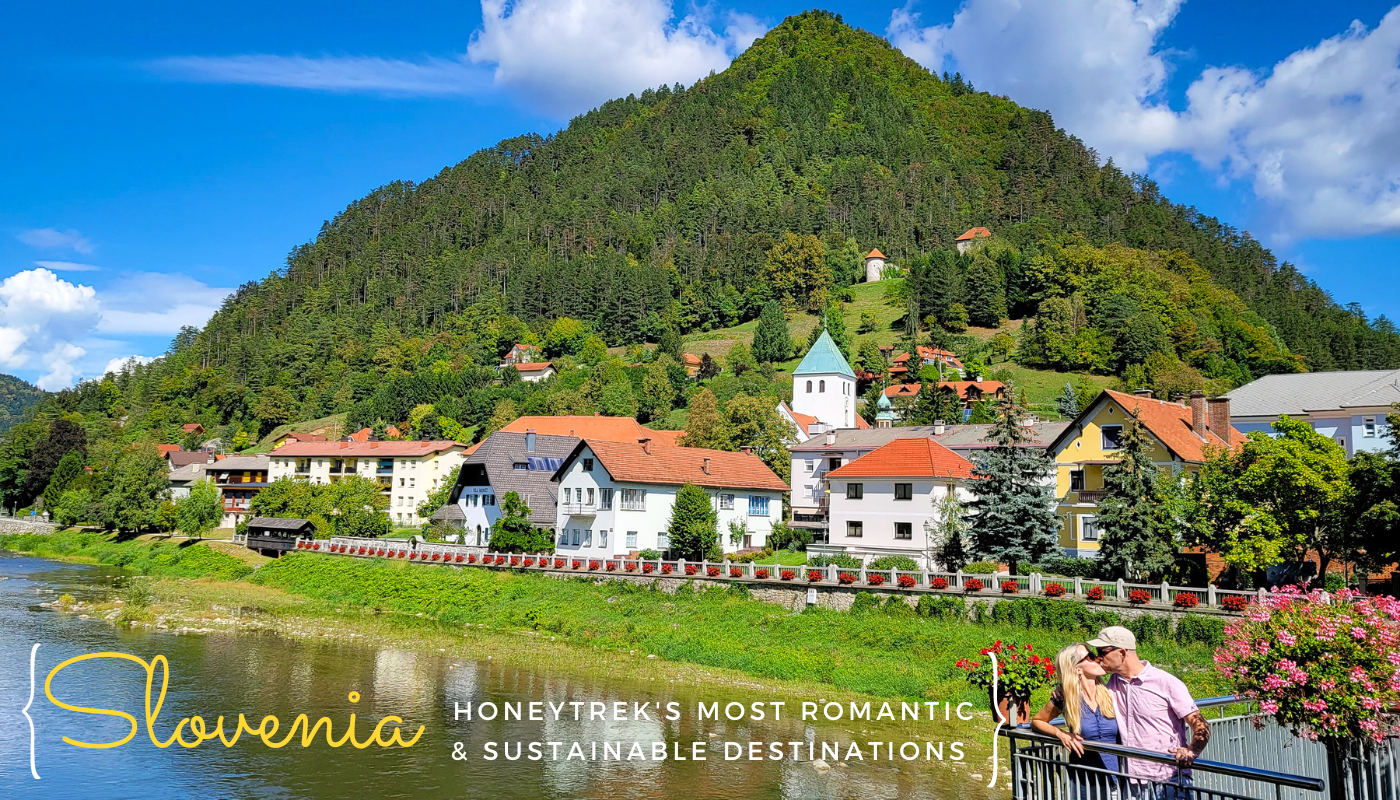
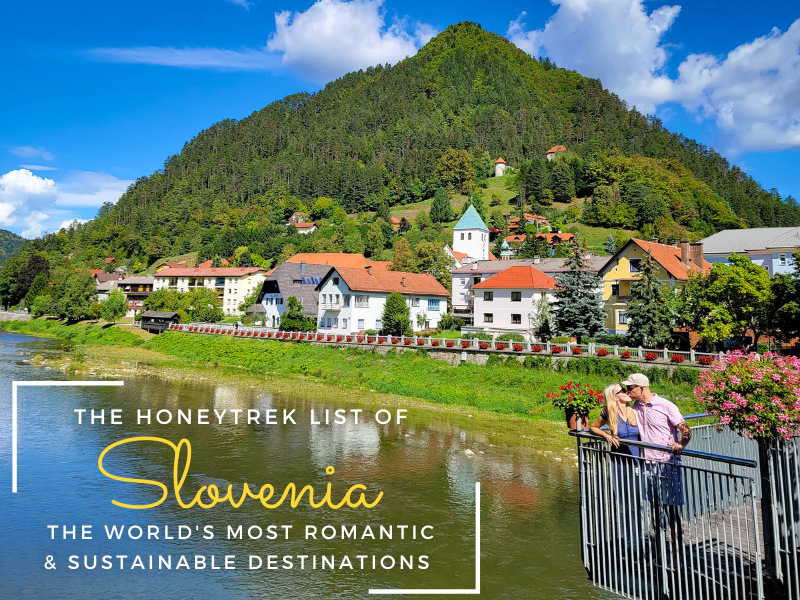 Slovenia is all the hotness right now. This tiny Balkan country made National Geographic’s Best of The World 2023, was named European Region of Gastronomy 2021, and its capital hit the number one spot for 2022 Best European Destination. And as the first country to be declared a “green destination” and the only one with “love” in its name, Slovenia was a shoo-in for HoneyTrek’s list of The World’s Most Romantic & Sustainable Destinations. Though to make sure (and have some fun along the way), we rented a electric vehicle to explore the alpine peaks, Adriatic coast, wine country, historic villages, and culinary scene around this little country with a whole lot of heart. Enjoy our Slovenia travel guide with highlights from our 500-mile road trip and start plotting your journey to one of our new favorite destinations!
Slovenia is all the hotness right now. This tiny Balkan country made National Geographic’s Best of The World 2023, was named European Region of Gastronomy 2021, and its capital hit the number one spot for 2022 Best European Destination. And as the first country to be declared a “green destination” and the only one with “love” in its name, Slovenia was a shoo-in for HoneyTrek’s list of The World’s Most Romantic & Sustainable Destinations. Though to make sure (and have some fun along the way), we rented a electric vehicle to explore the alpine peaks, Adriatic coast, wine country, historic villages, and culinary scene around this little country with a whole lot of heart. Enjoy our Slovenia travel guide with highlights from our 500-mile road trip and start plotting your journey to one of our new favorite destinations!
Slovenia History 101
 Slovenia is a relatively new country with a wild history. Tucked between Italy, Croatia, Austria, and Hungary, the Slovenian territory is only 7,827 square miles (smaller than New Jersey) and has been deeply influenced by its neighbors and a variety of rulers. It was a part of the Holy Roman Empire for nearly 1,000 years, under Hapsburg rule from the mid 1500s through 1918, and part of the Socialist Republic of Yugoslavia until the 1990s. Sharing Slavic languages and a place on the Balkan peninsula, Slovenia, Croatia, Bosnia & Herzegovina, Macedonia, Montenegro, and Serbia were unified under the masterful (and some say dictatorial) rule of president Josip Broz Tito. He suppressed religious and ethnic differences, while rallying around the concept of one socialist nation, operating in near isolation from Europe and Russia. In some ways, Yugoslavia succeeded under Tito’s rule, but when he passed away in the 1980s, the young country started to crumble and then further divided under the dictator Slobodan Milošević. The economically stable and European-minded Slovenia declared their independence from Yugoslavia on June 25, 1991 and managed to accomplish it with only 10 days of battle (not the years of war endured by many of their Yugoslav counterparts to the east). Slovenia quickly got on the road to democracy, became a part of the European Union in 2004, and has been thriving ever since.
Slovenia is a relatively new country with a wild history. Tucked between Italy, Croatia, Austria, and Hungary, the Slovenian territory is only 7,827 square miles (smaller than New Jersey) and has been deeply influenced by its neighbors and a variety of rulers. It was a part of the Holy Roman Empire for nearly 1,000 years, under Hapsburg rule from the mid 1500s through 1918, and part of the Socialist Republic of Yugoslavia until the 1990s. Sharing Slavic languages and a place on the Balkan peninsula, Slovenia, Croatia, Bosnia & Herzegovina, Macedonia, Montenegro, and Serbia were unified under the masterful (and some say dictatorial) rule of president Josip Broz Tito. He suppressed religious and ethnic differences, while rallying around the concept of one socialist nation, operating in near isolation from Europe and Russia. In some ways, Yugoslavia succeeded under Tito’s rule, but when he passed away in the 1980s, the young country started to crumble and then further divided under the dictator Slobodan Milošević. The economically stable and European-minded Slovenia declared their independence from Yugoslavia on June 25, 1991 and managed to accomplish it with only 10 days of battle (not the years of war endured by many of their Yugoslav counterparts to the east). Slovenia quickly got on the road to democracy, became a part of the European Union in 2004, and has been thriving ever since.
Slovenia Road Trip Route
The alps, wine country, beaches, lowlands and uplands, medieval villages, cosmopolitan cities, and Karst subterranean worlds, Slovenia packs a lot within its borders. The country is only 200 miles across from the Adriatic Sea in the southwest to the Hungarian border in the northeast, but we zigzagged over 500 miles to explore the best of this gorgeous and charming country. Renting an e-vechicle is definitely the best way to explore this eco-minded destination. While we were initially a little nervous relying on a VW e-Golf battery to scale the alps, Slovenia has charging stations all over the place and we have extensive rental car coverage through our Allianz travel insurance, so we decided to was the time to give it a go! We did this route over the course of 11 days and it deserved every bit of that time, if not more!
TIP: Check out the tourism board’s excellent site Slovenia.info for more helpful trip planning tools and keep an eye out for their “Slovenia Green” label destinations, hotels, and activities to surface the most sustainable experiences.
Slovenia’s Capital of Ljubljana
 Built along the foothills of the Kamnik Alps and Ljubljanica river, the capital of Slovenia is inherently beautiful with glorious architecture dating back to the Romans. To preserve its history and charm, the old town shut traffic to cars over a decade ago and replaced them with a fantastic bike program and free electric “Kavalir” shuttles for whenever you need a lift (one of the many reasons they won “Green Capital of Europe in 2016). There is an active, youthful air about the city—thanks to its 50,000 university students. Everyone was out making the most of the river, from stand-up paddleboarding to outdoor dining at one of the many waterfront bars and restaurants. We crossed over the iconic triple bridge designed by Jože Plečnik, a Slovenian architect so inventive that his work is protected by UNESCO, to Prešeren Square. The pretty pink 17th-century church and statue of the square’s namesake poet is where everyone gathers, be it for concerts, protests, or to kickoff city-wide adventures. Narrow streets lead to the central market square, bustling with produce vendors and surrounded by cafes, like the yummy Moji štruklji. We ate traditional Slovenian dumplings (tightly rolled, not stuffed, with sweet or savory fillings). For an afternoon drink, we walked into an unsuspecting Art-Deco bank and took the elevator to the 12th floor where the Neboticnik rooftop bar offers panoramic views of the city. Ljubljana Castle on the hilltop dominated the vista and beckoned us closer. It’s free to enter the medieval complex, where restaurants and cultural events take place and the views get even better. Buy tickets to partake in the various exhibits and experiences—including everything from Slovenian History to the Culinary Time Machine six-course tasting. After a great day, we retired to Hotel One66, lodging so sustainable it’s achieved the international Green Key designation. Their diligent efforts to conserve energy, reduce water, and minimize waste are impressive, as is their hip design. We walked through a veritable art gallery to reach our room. Bold colors and patterns accented mid-century furniture for a retro Yugoslavia vibe. We got the Couples Goals Package (recommend!) which came with a bottle of sparkling wine and a late checkout to enjoy our suite, a leisurely breakfast from their in-house Airstream food truck, and take their free bikes for a spin before we hit the highway. (Check out their glamping cabins, coming soon!)
Built along the foothills of the Kamnik Alps and Ljubljanica river, the capital of Slovenia is inherently beautiful with glorious architecture dating back to the Romans. To preserve its history and charm, the old town shut traffic to cars over a decade ago and replaced them with a fantastic bike program and free electric “Kavalir” shuttles for whenever you need a lift (one of the many reasons they won “Green Capital of Europe in 2016). There is an active, youthful air about the city—thanks to its 50,000 university students. Everyone was out making the most of the river, from stand-up paddleboarding to outdoor dining at one of the many waterfront bars and restaurants. We crossed over the iconic triple bridge designed by Jože Plečnik, a Slovenian architect so inventive that his work is protected by UNESCO, to Prešeren Square. The pretty pink 17th-century church and statue of the square’s namesake poet is where everyone gathers, be it for concerts, protests, or to kickoff city-wide adventures. Narrow streets lead to the central market square, bustling with produce vendors and surrounded by cafes, like the yummy Moji štruklji. We ate traditional Slovenian dumplings (tightly rolled, not stuffed, with sweet or savory fillings). For an afternoon drink, we walked into an unsuspecting Art-Deco bank and took the elevator to the 12th floor where the Neboticnik rooftop bar offers panoramic views of the city. Ljubljana Castle on the hilltop dominated the vista and beckoned us closer. It’s free to enter the medieval complex, where restaurants and cultural events take place and the views get even better. Buy tickets to partake in the various exhibits and experiences—including everything from Slovenian History to the Culinary Time Machine six-course tasting. After a great day, we retired to Hotel One66, lodging so sustainable it’s achieved the international Green Key designation. Their diligent efforts to conserve energy, reduce water, and minimize waste are impressive, as is their hip design. We walked through a veritable art gallery to reach our room. Bold colors and patterns accented mid-century furniture for a retro Yugoslavia vibe. We got the Couples Goals Package (recommend!) which came with a bottle of sparkling wine and a late checkout to enjoy our suite, a leisurely breakfast from their in-house Airstream food truck, and take their free bikes for a spin before we hit the highway. (Check out their glamping cabins, coming soon!)
TIP: Make the most of your time in the city with the Ljubljana Card which gets you into 20 major attractions, offers a city tour, and virtually every mode of transit (including 4-hours of free bike rental, a boat cruise, and the funicular to the castle.) Either way, set yourself up with the city’s BicikeLJ bike system—it’s only 1 euro for the week!
Kamnik-Savinja Alps & Vila Planinka
 Within an hour’s drive of the city, the Kamnik-Savinja Alps came into view and pastures turned into narrow canyons. Not a common stop on the tourist circuit, Jezersko Valley is a coveted spot for mountaineers and luxury travelers in the know. We read about Vila Planinka in some travel magazine which raved about their food, wine, and sustainability ethos and just knew we had to get there someday. We walked into this 1930s chalet turned contemporary boutique hotel and could feel the positive vibes of this place, from the energy points it’s built on to the convivial sommelier. He handed us a glass of wine to kick off the check-in process on the patio, where the sheer peaks seemed to spring from the pavers and bring the Skuta Glacier so close we could feel its chill. He told us about their restaurant, natural wine workshops, spa services, and adventure offerings, then led us to our room, The Lady Slipper. A kitchen, living room with a fireplace, wrap-around porch and bedroom with mountain view had our jaws on the floor. “Enjoy your stay and we will see you downstairs for your Orange Revolution Wine Tasting.” The hotel’s cellar holds over 250 Slovenian wines with an emphasis on “orange wines,” a Slovenian biodynamic tradition of winemaking that predates Roman settlement and has been having a renaissance in recent decades. Sommelier and accomplished wine expert, Marko Koren, set the table with not just glasses and spittoons, but lemons, salt, radicchio and more tools to bring out the characteristics of the wines. Maps covered the nine Slovenian wine-making regions from coastal to karst, and our seven-stage tasting featured iconic wineries from Mlečnik to Gravner showcasing the best of these organic, slow maceration wines. It was the father of Slovenian biodynamic wine Rudolf Steiner’s belief that a vineyard is not a plot but a living organism affected by the minerality, astrality, spirituality, and principles of life. With mother nature and ancient tradition as their guide, Slovenian biodynamic wines can’t be mass produced or mass exported around the globe…you have to come here to experience them! Our tasting flowed into a dinner at their Michelin-rated restaurant where course after course of vegan dishes appeared like art on a platter.
Within an hour’s drive of the city, the Kamnik-Savinja Alps came into view and pastures turned into narrow canyons. Not a common stop on the tourist circuit, Jezersko Valley is a coveted spot for mountaineers and luxury travelers in the know. We read about Vila Planinka in some travel magazine which raved about their food, wine, and sustainability ethos and just knew we had to get there someday. We walked into this 1930s chalet turned contemporary boutique hotel and could feel the positive vibes of this place, from the energy points it’s built on to the convivial sommelier. He handed us a glass of wine to kick off the check-in process on the patio, where the sheer peaks seemed to spring from the pavers and bring the Skuta Glacier so close we could feel its chill. He told us about their restaurant, natural wine workshops, spa services, and adventure offerings, then led us to our room, The Lady Slipper. A kitchen, living room with a fireplace, wrap-around porch and bedroom with mountain view had our jaws on the floor. “Enjoy your stay and we will see you downstairs for your Orange Revolution Wine Tasting.” The hotel’s cellar holds over 250 Slovenian wines with an emphasis on “orange wines,” a Slovenian biodynamic tradition of winemaking that predates Roman settlement and has been having a renaissance in recent decades. Sommelier and accomplished wine expert, Marko Koren, set the table with not just glasses and spittoons, but lemons, salt, radicchio and more tools to bring out the characteristics of the wines. Maps covered the nine Slovenian wine-making regions from coastal to karst, and our seven-stage tasting featured iconic wineries from Mlečnik to Gravner showcasing the best of these organic, slow maceration wines. It was the father of Slovenian biodynamic wine Rudolf Steiner’s belief that a vineyard is not a plot but a living organism affected by the minerality, astrality, spirituality, and principles of life. With mother nature and ancient tradition as their guide, Slovenian biodynamic wines can’t be mass produced or mass exported around the globe…you have to come here to experience them! Our tasting flowed into a dinner at their Michelin-rated restaurant where course after course of vegan dishes appeared like art on a platter.
Jezersko Valley
 The next morning we did a bike and hike combo to enjoy the alps and village life. The Villa Planinka receptionist is also history buff and local guide who tipped us off to visit St Oswald’s Church (which boasts some of the oldest frescoes in Slovenia), the locals hangout of Planšarsko Lake cafe, and the village’s natural mineral water springs. After a 20-minute ride through the gorgeous Ravenske Kocne Glacial Valley we reached the trailhead to Golvinar Peak. Ever go on a hike where the base is so pretty you feel like you’ve already made it to the pinnacle? That’s how we felt here, but we still did the steep climb through the forest and reached (and crossed) the border of Austria! A ranger had carved a heart bench on the ridge, which enticed to sit and watch the clouds swirl around the peaks for almost an hour. These same mountains are where renowned Slovenian alpinists trained to be the first people to ski Annapurna Mountain and Mount Everest from peak to basecamp! Maybe we should come back in the winter and bring our skis…
The next morning we did a bike and hike combo to enjoy the alps and village life. The Villa Planinka receptionist is also history buff and local guide who tipped us off to visit St Oswald’s Church (which boasts some of the oldest frescoes in Slovenia), the locals hangout of Planšarsko Lake cafe, and the village’s natural mineral water springs. After a 20-minute ride through the gorgeous Ravenske Kocne Glacial Valley we reached the trailhead to Golvinar Peak. Ever go on a hike where the base is so pretty you feel like you’ve already made it to the pinnacle? That’s how we felt here, but we still did the steep climb through the forest and reached (and crossed) the border of Austria! A ranger had carved a heart bench on the ridge, which enticed to sit and watch the clouds swirl around the peaks for almost an hour. These same mountains are where renowned Slovenian alpinists trained to be the first people to ski Annapurna Mountain and Mount Everest from peak to basecamp! Maybe we should come back in the winter and bring our skis…
Lake Bled
 Heading toward the Julian Alps, Lake Bled starts this region like a fairy tale. Jagged peaks surround the remarkably teal waters and in the middle of the lake a 17th-century church is perched on Slovenia’s only island. It’s a tradition for newlyweds to paddle in a traditional wooden boat to the Church of the Assumption of Mary and for the groom to carry his bride up the 99 steps and ring the bell for good luck. As much as I’m sure Mike wanted to throw me over his shoulder for ancient StairMaster, it was raining so we opted for the easier and equally romantic Bled Castle for lunch. Atop the lake cliffs and walls of the 1,000-year old Holy Roman fortress is perched Bled Castle Restaurant. He reserved a window table overlooking the waters and the vegan tasting menu, with everything from eggplant roulade to strawberry pistachio cake. After a whirl around the castle museum, we went to nearby Kralov Med…among the best places to get a taste of Slovenian beekeeping! The world’s first beekeeping school began in Slovenia and its master teacher’s birthday was chosen as the date of the UN recognized World Bee Day. Understanding their contribution to beekeeping and the importance of bees’ role in biodiversity, Slovenia has more beekeepers per capita than any other nation. The family behind Kralov Med has been beekeeping for over a century and aims to make this tradition more approachable, with honey harvesting demonstrations, beeswax candle-making, even apitherapy, where you can meditate among the hives. We laid down on the beds next to the bee boxes, listening to the whirl of activity and breathing in the fragrant air, followed by a tasting of honey products made from the very bees we bonded with.
Heading toward the Julian Alps, Lake Bled starts this region like a fairy tale. Jagged peaks surround the remarkably teal waters and in the middle of the lake a 17th-century church is perched on Slovenia’s only island. It’s a tradition for newlyweds to paddle in a traditional wooden boat to the Church of the Assumption of Mary and for the groom to carry his bride up the 99 steps and ring the bell for good luck. As much as I’m sure Mike wanted to throw me over his shoulder for ancient StairMaster, it was raining so we opted for the easier and equally romantic Bled Castle for lunch. Atop the lake cliffs and walls of the 1,000-year old Holy Roman fortress is perched Bled Castle Restaurant. He reserved a window table overlooking the waters and the vegan tasting menu, with everything from eggplant roulade to strawberry pistachio cake. After a whirl around the castle museum, we went to nearby Kralov Med…among the best places to get a taste of Slovenian beekeeping! The world’s first beekeeping school began in Slovenia and its master teacher’s birthday was chosen as the date of the UN recognized World Bee Day. Understanding their contribution to beekeeping and the importance of bees’ role in biodiversity, Slovenia has more beekeepers per capita than any other nation. The family behind Kralov Med has been beekeeping for over a century and aims to make this tradition more approachable, with honey harvesting demonstrations, beeswax candle-making, even apitherapy, where you can meditate among the hives. We laid down on the beds next to the bee boxes, listening to the whirl of activity and breathing in the fragrant air, followed by a tasting of honey products made from the very bees we bonded with.
Bohinj Valley & The Julian Alps
Too many people reach Bled and think, “It can’t get better than this,” but it does, so keep going guys! All of Slovenia’s Julian Alps are a wonderland of soaring peaks, waterfalls, and rich alpine culture…and it all culminates in the Bohinj Valley. Home to a UNESCO Biosphere Reserve, Slovenia’s only national park, and its largest natural lake, this region had us hiking and biking our hearts out. Staying at Hotel Bohinj, we were perfectly situated along the lake and in striking distance to the historic Voje Valley, the snaking Mostnica Gorge, and the 255-foot high Savica Waterfall. By night, we refueled with their farm-to-table cuisine, divine spa, and sexy suites. The icing on the cake of our Bohinj getaway? The Cows’ Ball! We caught the valley’s largest (and most adorable!) annual festival of alpine culture, with the farmers in traditional dress and everyone dancing their knee-socks off. Watch this video to feel the energy and fun of this must-experience event.
TIP: Plan your Bohinj adventures with Hike & Bike. They lead fantastic trips, from multi-day biking or day hikes to the stunning Triglav Lakes. And if you are looking to stay tucked in the mountains, they also have adorable chalets.
Soča River Valley: The Land of Narnia
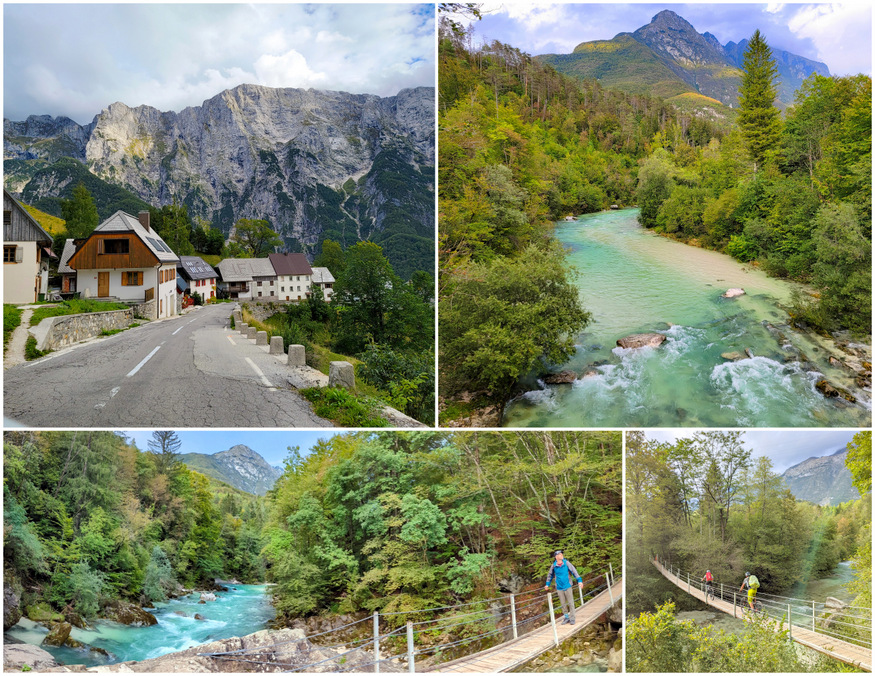 Driving back out of the valley through Bled (so nice, we were happy to see it twice), we didn’t realize that our GPS had us going through the Italian alps to get to our next Slovenian destination! What started as a bit of panic, as all the signs changed languages and our cell phone plans stopped working, turned out to be a stunning drive through Travesio, back towards Slovenia’s tallest mountain, Mount Triglav. Each bend in the road revealed a new jaw-dropping view, all the way to the adventure hub of Bovec village. Hotel Soča is a great jumping-off point and outfitter for the Soča River’s many adventures. If this stunning river looks like something out of the Chronicles of Narnia movie, it’s because the Soča was one of their filming locations! Canyoneering, abseiling down waterfalls and sliding into swimming holes, is supposed to be absolutely incredible here (we will be back!), as was the hike we took along the Soča Trail.
Driving back out of the valley through Bled (so nice, we were happy to see it twice), we didn’t realize that our GPS had us going through the Italian alps to get to our next Slovenian destination! What started as a bit of panic, as all the signs changed languages and our cell phone plans stopped working, turned out to be a stunning drive through Travesio, back towards Slovenia’s tallest mountain, Mount Triglav. Each bend in the road revealed a new jaw-dropping view, all the way to the adventure hub of Bovec village. Hotel Soča is a great jumping-off point and outfitter for the Soča River’s many adventures. If this stunning river looks like something out of the Chronicles of Narnia movie, it’s because the Soča was one of their filming locations! Canyoneering, abseiling down waterfalls and sliding into swimming holes, is supposed to be absolutely incredible here (we will be back!), as was the hike we took along the Soča Trail.
Vipava Valley & Theodosius Glamping
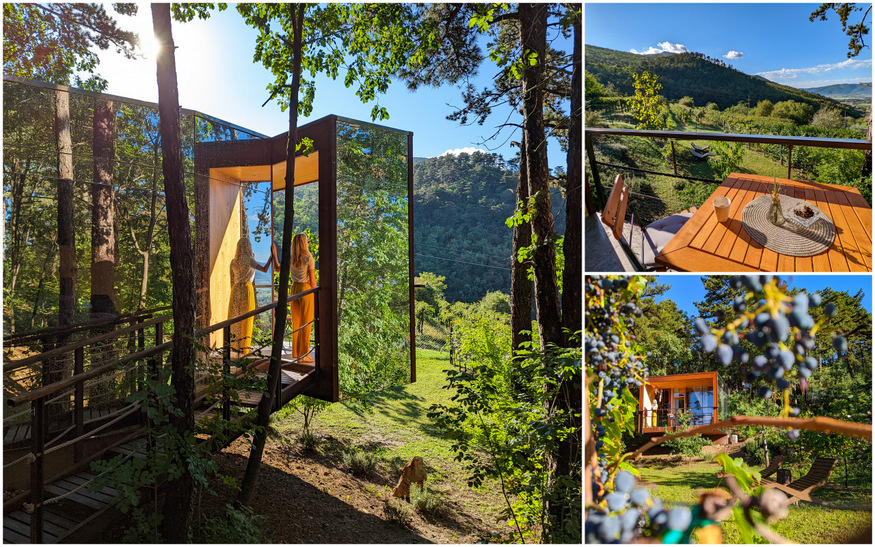 Leaving the mountains, the landscape rolls into Slovenia’s premier vineyards and dives deep into their karst landscape. To get the best of the Primorska wine region and the country’s impressive cave systems, we positioned ourselves in Vipava Valley and Theodosius Forest Village. This glamping camp is set high in the hills, among a 100-year-old pine forest and a sea of grape vines. To build this property to Green-Key standards, they didn’t cut down any trees or use heavy machinery on the land, and hand-carried local materials to each forested site. The cabins are the perfect balance of rustic and modern, including their showstopping mirrored cube. With walls that reflect back the surrounding trees, it virtually vanished in the forest, yet called to us like a secret hiding place. The front was all windows with a patio for valley views that seemed to stretch to the Adriatic. For breakfast they prepared an ITALICS TK impressive vegan spread of grilled veggies, plant-based sausages, butter-free croissants, and fresh fruit from Vipava’s fertile valley. We asked the hostess about the origin of the property name and it turns out that in 394 AD this village is where Theodosius won the Battle of Frigidus with the help of the valley’s strong “burja” wind. For more Roman history, you can visit the nearby remains of the Castra Fortress, which has the largest surviving Roman wall in Slovenia, and learn about their legacy in the nearby Ajdovščina Museum Collection.
Leaving the mountains, the landscape rolls into Slovenia’s premier vineyards and dives deep into their karst landscape. To get the best of the Primorska wine region and the country’s impressive cave systems, we positioned ourselves in Vipava Valley and Theodosius Forest Village. This glamping camp is set high in the hills, among a 100-year-old pine forest and a sea of grape vines. To build this property to Green-Key standards, they didn’t cut down any trees or use heavy machinery on the land, and hand-carried local materials to each forested site. The cabins are the perfect balance of rustic and modern, including their showstopping mirrored cube. With walls that reflect back the surrounding trees, it virtually vanished in the forest, yet called to us like a secret hiding place. The front was all windows with a patio for valley views that seemed to stretch to the Adriatic. For breakfast they prepared an ITALICS TK impressive vegan spread of grilled veggies, plant-based sausages, butter-free croissants, and fresh fruit from Vipava’s fertile valley. We asked the hostess about the origin of the property name and it turns out that in 394 AD this village is where Theodosius won the Battle of Frigidus with the help of the valley’s strong “burja” wind. For more Roman history, you can visit the nearby remains of the Castra Fortress, which has the largest surviving Roman wall in Slovenia, and learn about their legacy in the nearby Ajdovščina Museum Collection.
The Mother of Slovenian Caves: Postonja
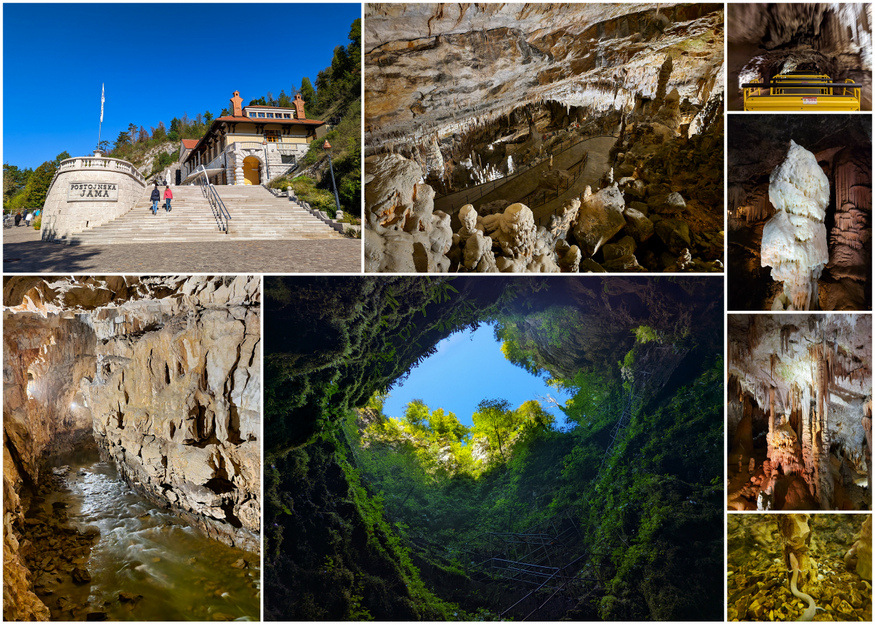 While it was tempting to start wine tasting around the 40+ vineyards of the Vipava Valley, we had a tour to catch at the legendary Postojna Cave. Discovered in 1818 and still the largest show cave in Europe, this is where the study of caves (speleology) literally began! We were issued our hard hats and boarded a train into the 24 km-long cave system. The train has been in operation for over 140 years, bringing everyone from King Ferdinand I to Thomas Cook, who included it on his first trip around the world in the 1873. We traveled through the labyrinth of stalactites and stalagmites, into a subterranean ballroom and concert hall that are still used today, and reached the main cave. Our guide pointed out impressive features like “The Brilliant,” a thick, bright-white limestone formation and “The Skyscraper” standing at 52-feet tall. The main cave is actually 1 of 5 in the system and they have a slew of adventure tours where you can even go legit caving with ropes and river crossings. The river was too full for abseiling during our visit (take the “In the Footsteps of Luka Čeč” tour if you can!), so we opted for the Double Karst Marvel Experience through the Pivka and Crna Caves…and it was awesome! The “Crna” or Black Cave boasts wonderful flowstone formations, while the Pivka Cave path follows a vanishing subterranean river. What started as a drip through the porous rocks three-million years ago has become one of the most dazzling cave systems in the world. This unique ecosystem has also created habitat for 150 animal species, including the “baby dragons,” which can live for up to a century and go for eight years without food. This place is certainly one of extremes and worth the hype!
While it was tempting to start wine tasting around the 40+ vineyards of the Vipava Valley, we had a tour to catch at the legendary Postojna Cave. Discovered in 1818 and still the largest show cave in Europe, this is where the study of caves (speleology) literally began! We were issued our hard hats and boarded a train into the 24 km-long cave system. The train has been in operation for over 140 years, bringing everyone from King Ferdinand I to Thomas Cook, who included it on his first trip around the world in the 1873. We traveled through the labyrinth of stalactites and stalagmites, into a subterranean ballroom and concert hall that are still used today, and reached the main cave. Our guide pointed out impressive features like “The Brilliant,” a thick, bright-white limestone formation and “The Skyscraper” standing at 52-feet tall. The main cave is actually 1 of 5 in the system and they have a slew of adventure tours where you can even go legit caving with ropes and river crossings. The river was too full for abseiling during our visit (take the “In the Footsteps of Luka Čeč” tour if you can!), so we opted for the Double Karst Marvel Experience through the Pivka and Crna Caves…and it was awesome! The “Crna” or Black Cave boasts wonderful flowstone formations, while the Pivka Cave path follows a vanishing subterranean river. What started as a drip through the porous rocks three-million years ago has become one of the most dazzling cave systems in the world. This unique ecosystem has also created habitat for 150 animal species, including the “baby dragons,” which can live for up to a century and go for eight years without food. This place is certainly one of extremes and worth the hype!
TIP: Extend your trip at Park Postojnska Jama and spring for the combo ticket to Predjama Castle, a massive medieval marvel built into a 400-foot-high cliff and with a network of secret tunnels.
The Slovenian Coast & Dazzling Piran
 Slovenia may only have 29 miles of coast but it connects them to a larger Istrian culture that extends from Croatia to Italy. In fact, this area was part of the Venetian Republic for over 500 years, Italians were the ethnic majority here until the 20th century, and the region is still bilingual! Piran is the gem of the Slovenian coast, a walled medieval city with more boats than cars. To minimize traffic and preserve their historic atmosphere, they’ve made the old town streets almost entirely pedestrian and offer free shuttles to and from the center. (FYI If you are driving here, there is a big parking garage by the start of the bus route). We were dropped off at Tartini Square, and we immediately felt the Italian influence, with its pointed arches and colonnaded balconies, a clock tower that mimics that of Piazza San Marco, and Venice’s signature winged lion overlooking town. We joined a wonderful tour with Jan of Piran Walking Tours, who took us through the narrow streets to First of May Square, the Convent of San Francisco, and up to the Cathedral of St George for views to three countries! You can also walk the town walls for a small fee and even better views of the coast. For dinner we were treated to an eight-course tasting menu at Stara Gostilna, home of Slovenia’s youngest Michelin-awarded chef and one of the city’s oldest residences. Each dish arrived like works of art–from the handmade ceramics the food was plated to the interactive way each dish was served. Tomato tartare with pickled grapes and pistachio crust, barley risotto with peach gazpacho, pumpkin terrine with mango caviar, and rhubarb mousse with caramelized walnuts were just some of the divine courses. We got chatting with owner Donata, and before you know it she was showing us her kitchen herb garden, photos from the early days of the restaurant (in its 26th year) and her secret B&B upstairs. Long story, but we didn’t have a place to sleep that night and she insisted we be her guest. Thank you for your incredible hospitality, Donata!
Slovenia may only have 29 miles of coast but it connects them to a larger Istrian culture that extends from Croatia to Italy. In fact, this area was part of the Venetian Republic for over 500 years, Italians were the ethnic majority here until the 20th century, and the region is still bilingual! Piran is the gem of the Slovenian coast, a walled medieval city with more boats than cars. To minimize traffic and preserve their historic atmosphere, they’ve made the old town streets almost entirely pedestrian and offer free shuttles to and from the center. (FYI If you are driving here, there is a big parking garage by the start of the bus route). We were dropped off at Tartini Square, and we immediately felt the Italian influence, with its pointed arches and colonnaded balconies, a clock tower that mimics that of Piazza San Marco, and Venice’s signature winged lion overlooking town. We joined a wonderful tour with Jan of Piran Walking Tours, who took us through the narrow streets to First of May Square, the Convent of San Francisco, and up to the Cathedral of St George for views to three countries! You can also walk the town walls for a small fee and even better views of the coast. For dinner we were treated to an eight-course tasting menu at Stara Gostilna, home of Slovenia’s youngest Michelin-awarded chef and one of the city’s oldest residences. Each dish arrived like works of art–from the handmade ceramics the food was plated to the interactive way each dish was served. Tomato tartare with pickled grapes and pistachio crust, barley risotto with peach gazpacho, pumpkin terrine with mango caviar, and rhubarb mousse with caramelized walnuts were just some of the divine courses. We got chatting with owner Donata, and before you know it she was showing us her kitchen herb garden, photos from the early days of the restaurant (in its 26th year) and her secret B&B upstairs. Long story, but we didn’t have a place to sleep that night and she insisted we be her guest. Thank you for your incredible hospitality, Donata!
Portoroz: Salt, Olives, & Spas

Did you know the world “salary” derives from being paid in salt (once among the most valuable currencies)? Piran’s wealth and influence goes back to its salt pans in nearby Portoroz. No longer the region’s main industry, but still an important part of the area’s history and wetland habitat, Sečovlje Salt Pans are now a nature park, Museum of Salt-Making, and a thalassotherapy spa to capitalize on the water’s health benefits. Set in the middle of ancient salt pans and wildlife sanctuary, Lepa Vida Thalasso Spa is pure serenity–from its gorgeous setting to laid back vibe. Without the pretension of many spas, they offer salt pools, brine baths, stone treatments & gorgeous lounge areas at a mere €25 for two hours! We leveled it up with an outdoor mud wrap, enjoying the sea views, birdlife, and Slovenian wine, leaving with a feeling of rejuvenation (and the softest skin!). Another speciality of this area? Olives. Just above the salt pans, the fourth-generation Gramona Eco farm has orchards of olives in a dozen varieties. They’ve won tons of awards for their oils and tapenades and say their secret is hard work, sun, sea breeze, and the saline microclimate. They showed us around the grounds, shared their permaculture processes, and finished with a wine and olive tasting overlooking the salt pans at sunset.
Northeast Slovenia Road Trip: Celje & Ptuj
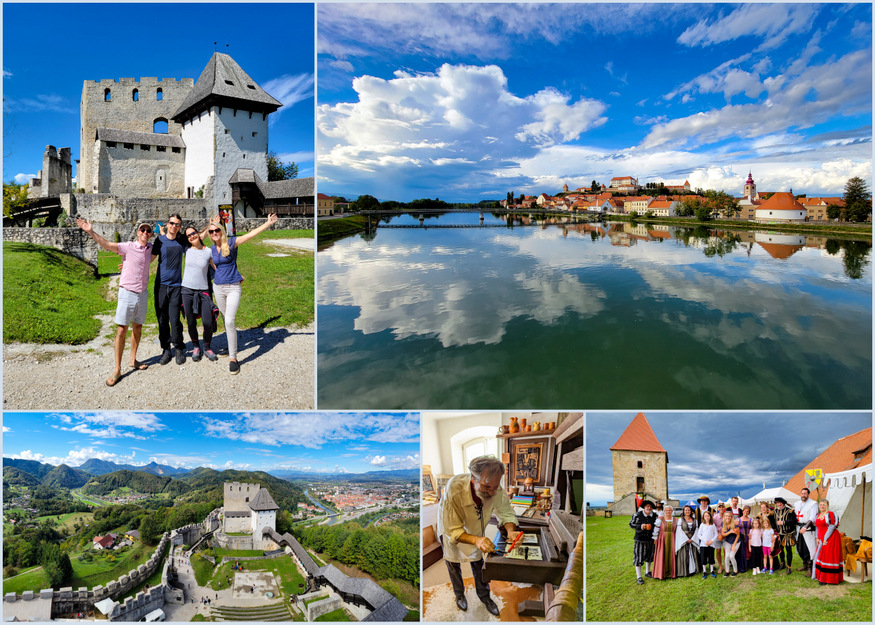 Our eight-day car rental was up, but we didn’t want to leave! So we returned it in Ljubljana and joined our Slovenian friends Ana & Jernej for a road trip to their favorite places in the northeast (where few tourists go and have no idea what they are missing!). First stop, Celje: Slovenia’s largest medieval castle and the former home to the country’s most influential dynasty. The structure is magnificent with a very well done museum, including Middle-Ages craft demonstrations, the craziest medieval torture exhibit, and breathtaking views from the tower. (You’d think the mountains wouldn’t be too impressive outside the alps but wrong-o!) With a festival to catch, we pressed on to Ptuj, the oldest recorded city in Slovenia (est 3rd century BCE). Their calm, shallow spot along the Drava River made it a key point on the prehistoric trade route between the Baltic and the Adriatic Seas. They are quite proud of their history and have festivals throughout the year (the pagan Kurentovanje parade is supposed to be incredible) and we happened to be there for the Ptuj Castle Games, where archery and broadsword fighting are accompanied by art demonstrations, a winemaking competition, and traditional music and dance. With no Americans at the festival, we were quickly adopted by a family of knights and maidens and clinking ceramic mugs of mead. Slovenians are so darn nice.
Our eight-day car rental was up, but we didn’t want to leave! So we returned it in Ljubljana and joined our Slovenian friends Ana & Jernej for a road trip to their favorite places in the northeast (where few tourists go and have no idea what they are missing!). First stop, Celje: Slovenia’s largest medieval castle and the former home to the country’s most influential dynasty. The structure is magnificent with a very well done museum, including Middle-Ages craft demonstrations, the craziest medieval torture exhibit, and breathtaking views from the tower. (You’d think the mountains wouldn’t be too impressive outside the alps but wrong-o!) With a festival to catch, we pressed on to Ptuj, the oldest recorded city in Slovenia (est 3rd century BCE). Their calm, shallow spot along the Drava River made it a key point on the prehistoric trade route between the Baltic and the Adriatic Seas. They are quite proud of their history and have festivals throughout the year (the pagan Kurentovanje parade is supposed to be incredible) and we happened to be there for the Ptuj Castle Games, where archery and broadsword fighting are accompanied by art demonstrations, a winemaking competition, and traditional music and dance. With no Americans at the festival, we were quickly adopted by a family of knights and maidens and clinking ceramic mugs of mead. Slovenians are so darn nice.
Radgonsko-Kapelski: Vineyards & Farmstay
 That night we slept at Domačija Firbas in their adorable A-frame glamping cabins tucked amongst the apple orchards of this family farm. We woke up for breakfast, a glorious spread cooked over an open-fire, accompanied by homemade jams, breads, juices, and more delights from their garden. The son Bojan gave us a tour of the property including the hayloft apartment, where you can sleep above animals, listen to their rumblings and watch them through the glass floor! After meeting the sheep, pigs, cows, and rabbits, he showed us to the e-bike barn for our day’s adventures. Being located in the Radgonsko–Kapelski wine-growing region, vineyards were a short ride away, as were castles, mineral springs, and cute towns. We weren’t pedaling for more than 15 minutes and were pulled into a grape-harvesting and wine tasting session with a local family! They sent us away with two bottles of their Riesling wine and told us the traditional way to drink it is to add mineral water from the nearby springs. We biked until we saw a fountain by the stream, and low and behold the water was coming out bubbly! We mixed ourselves an iron-fortified wine spritz and decided we needed a bit more wine with a tasting at Vinska Fontana. Perched on a hill next to a beautiful old church and overlooking the vines, it is a fantastic wine bar serving local wines, including that of the cute young owners. Not just any tasting room, it’s a serve-yourself wine fountain dispenser where you scan a barcode and out comes the wine of your choice. Be sure to try Jurka, a regional and ancient grape varietal, and kickback in their lawn chairs to enjoy the view!
That night we slept at Domačija Firbas in their adorable A-frame glamping cabins tucked amongst the apple orchards of this family farm. We woke up for breakfast, a glorious spread cooked over an open-fire, accompanied by homemade jams, breads, juices, and more delights from their garden. The son Bojan gave us a tour of the property including the hayloft apartment, where you can sleep above animals, listen to their rumblings and watch them through the glass floor! After meeting the sheep, pigs, cows, and rabbits, he showed us to the e-bike barn for our day’s adventures. Being located in the Radgonsko–Kapelski wine-growing region, vineyards were a short ride away, as were castles, mineral springs, and cute towns. We weren’t pedaling for more than 15 minutes and were pulled into a grape-harvesting and wine tasting session with a local family! They sent us away with two bottles of their Riesling wine and told us the traditional way to drink it is to add mineral water from the nearby springs. We biked until we saw a fountain by the stream, and low and behold the water was coming out bubbly! We mixed ourselves an iron-fortified wine spritz and decided we needed a bit more wine with a tasting at Vinska Fontana. Perched on a hill next to a beautiful old church and overlooking the vines, it is a fantastic wine bar serving local wines, including that of the cute young owners. Not just any tasting room, it’s a serve-yourself wine fountain dispenser where you scan a barcode and out comes the wine of your choice. Be sure to try Jurka, a regional and ancient grape varietal, and kickback in their lawn chairs to enjoy the view!
Slovenian Food & Wine
Of the 70 countries we’ve experienced on our HoneyTrek, Slovenia just cracked our top five for fine dining. And while many regions of the world dazzle with a melange of spices, Slovenia’s approach is far simpler…stay fresh. Restaurants from the alps to the coast take great pride in sourcing locally, often growing or foraging for their produce. They understand how interconnected good food is with a healthy environment, and they work towards its preservation with organic farming, even beekeeping. They’ve been making wine since the 4th century BCE and have stayed true to their biodynamic traditions and are winning droves of awards for it. Slovenia is home to six Michelin Green Star restaurants, the highest rating for sustainable cuisine, and such eco-conscious practices helped earn them the 2021 European Region of Gastronomy. And we’ll give Slovenian chefs an extra point because they cooked us their finest without any meat or dairy. See how beautiful plant-based eating can be in this gallery of our favorite dining experiences–from harvesting olives before our oil tasting to hand-making plum dumplings with a Michelin-green-star chef!
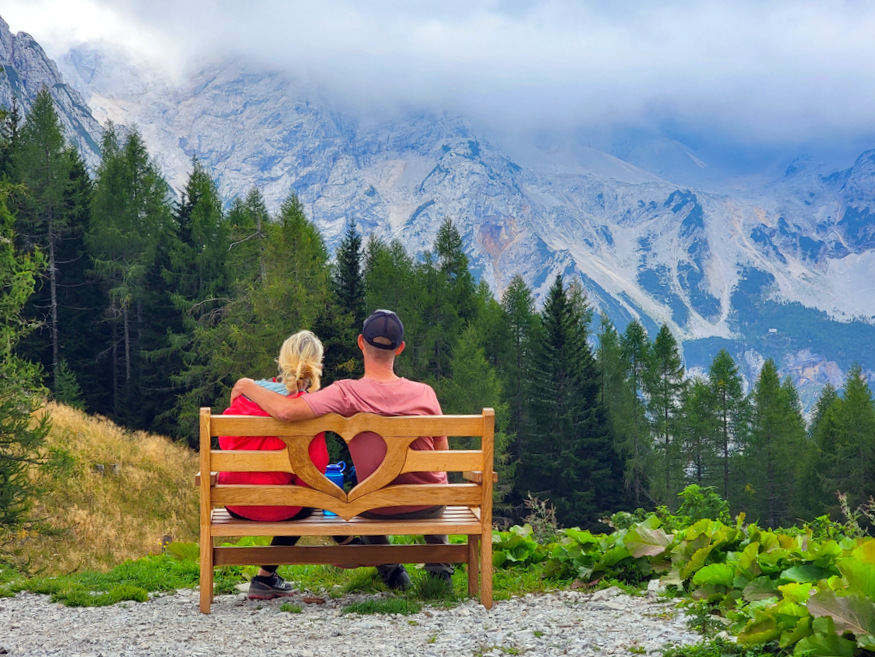 From their biodynamic wines to their recycling programs in remote mountain villages, Slovenia firmly earned its spot on our list of The World’s Most Romantic & Sustainable Destinations. Which town, hotel, restaurant, or experience called to you the most?
From their biodynamic wines to their recycling programs in remote mountain villages, Slovenia firmly earned its spot on our list of The World’s Most Romantic & Sustainable Destinations. Which town, hotel, restaurant, or experience called to you the most?
A huge thank you to our sponsor Allianz Travel Insurance for believing in the importance of sustainable travel and supporting eco-minded content creators like us!

